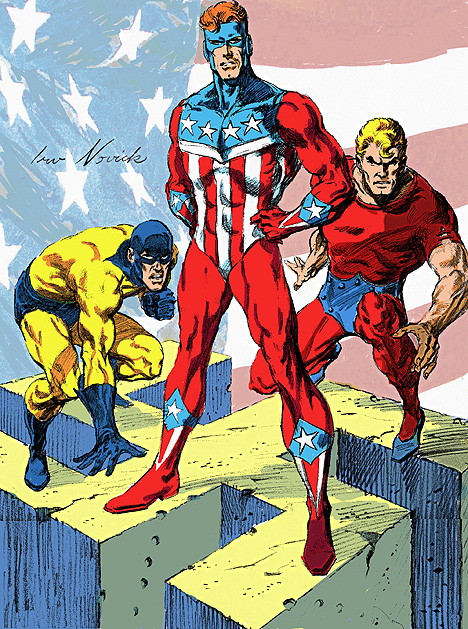Inspector Bentley of Scotland Yard: 1940 Pep Comics #1. Bentley routinely comes across supposed supernatural threats but exposes them as more mundane criminals. Luckily he carries a sturdy came that comes handy in a fight though he frequently breaks them. Plus like most of the Pep heroes, he’s an expert at Jiu-Jitsu.
NOTE: His strip had an Ellery Queen type shtick where the reader was invited to solve the mystery before reading the last page. Notable silver age artist Gil Kane actually did some work on this strip.
Black Hood: 1940, Top Notch Comics #9. Officer Kip Burland is framed by the criminal mastermind the Skull. In a remote locale, a hermit gives him the powers of the Black Hood (that’s what the text says, although I’m unaware of any super ability the Hood possesses) to stop the Skull.
Eventually the Skull is stopped and Burland goes back to the Force although he’d be suspected of other crimes over the year, but luckily the Black Hood is always able to prove his innocence. The love interest is Barbara Sutton who became a news photographer in order to be on hand to help the Black Hood. At some point, she became aware of his dual identity and would sometimes hold that over him in order to be allowed to help in a case.
In his last golden-age appearance, Kip Burland is unmasked by the Dick Tracy-esque villain Needlenoodle, so-called because of a large pointed head. I guess Banana Head was considered to ludicrous a name. He opens a private detective agency marketing on his Black Hood id and is still called the Black Hood though he no longer wears the costume. Since this is where the series ended, it’s hard to tell if this shift in motif would’ve been popular as the masked heroes craze was winding down. When the character was revived in the 60’s along with most of the other Mighty heroes, his unmasking (and leaving the police force) was conveniently forgotten.
NOTE: The Black Hood is MLJ’s sole multi-media star. He got his own short-lived pulp series and radio show. Why he was never picked up for a serial I don’t know.
Black Jack: 1941 Zip Comics #20. Jack Jones, nicknamed Black Jack because of his dark hair and favorite card game is an honest cop. He and another cop are betrayed by a third to Lucky Lavitto Warned by a gypsy woman that Black Jack would spell his doom, Lavitto has his men wall Jones up with the black jack card, jack of spades with him. However, Jack uses the card to dig through the wet cement to create an air hole until he’s rescued. He puts on a costume to put away the gangsters (because they "are afraid of the unknown") and crooked cop who betrayed him.
Black Witch: 1942, Zip Comics #26. The Black Witch tells tales of horror and doom to those that will listen (or read).
Bob Phantom: 1939, Blue Ribbon Comics #2. Newspaper columnist Walt Whitney is Bob Phantom (sometimes just ‘Phantom’). Able to appear and disappear in a cloud of smoke, strong enough to break apart concrete and possibly fly. I don’t know if his origin was ever given. Drawn by Irving Novick, he’s MLJ’s first superhero and one of the earliest of the genre as well. NOTE: According to a Ron Goulart piece on the history of MLJ (Comics Collector, Winter 1984), there was an even earlier Bob Phantom, a mustached magician (Shades of Mandrake!) that appeared in Harry "A" Chesler’s Star Comics #1, 1937.
Sgt. Boyle: 1940, Pep Comics #1. Sgt. Henry Boyle and his comic relief sidekick Captain Twerp fought the enemy wherever they found them. Boyle had a long running rivalry that stopped short of coming to blows with Corporal Collins and each would guest star in each other’s strip.
Burke of the Briny: 1939, Blue Ribbon Comics #1. Jack Burke and pal Scrappy Wallis spend a year and a half in "Princess Elizabeth Land" mining radium ore. What they don’t realize is that the spectre of a lost miner looms over them. This was a one-time strip.
Detective Sergeant Burke: 1940, Zip Comics #9. Burke is a two-fisted plain clothes detective for the New York Police Department. He appeared in a text story. Standard also had a Detective Sgt. Burke in Startling Comics.
Captain Commando: 1942, Pep Comics #30. Oddly, one of the few patriotic heroes to be created post Pearl Harbor. By the first story he’s been around awhile, fighting in places like Dunkirk, Norway, the Battle of Saint Nazaire. The kids, Billy Grayson of America, Erik Janson of Norway, Armand de Latour of France, and Gerald Sykes of England idolize him not realizing that the pacifistic and languid , John Grayson, father of Billy is really the Captain. They smuggle themselves aboard a ship heading out for another commando mission and become the ‘Boy Soldiers’. But even in costume, Billy is able to recognize his father.
Captain Flag: 1941, Blue Ribbon Comics #16. When the Nazi agent the Black Hand kills the father of the n’er-do-well Tom Townsend, Tom is saved only because a massive eagle carries him off. On a mountain top, he regains his strength and more and seeing an American flag he takes inspiration from that and returns to civilization as the patriotic Captain Flag.
Captain Valor: 1940, Zip Comics #1. Starts off as an adventurer and ex-Marine, but once the war starts up, he re-enlists. Aided by the beautiful Angie and her little brother Ronnie. In his early adventures, he is in China facing off against Ho Tsin. He's helped in this by a local leader Wang Fu and his forces. He also converts Big Dip, a giant Chinese henchman of Ho Tsin's.
Fu Chang, International Detective: 1940 Pep Comics 1-11. We’ll let the comic speak for us: Fu Chang, American university-educated Chinaman, makes his home in San Francisco’s Chinatown.
Because of his devotion to the teachings of the Chinese gods and because he has sworn his life to aid the oppressed, Sing Po, a famous magician and direct descendant of Aladdin, upon his death had willed to Fu Chang a set of magic chessmen. These chessmen possess all the magic powers of Aladdin’s lamp and are responsible for Fu Chang’s spectacular solutions of great International mysteries.
Talk about high concept! In his first appearance he saves Tay Ming from the Dragon who becomes his girlfriend (eventually fiancÈ) and helper. When Fu Chang dons traditional garb and prays to the statue of his god, the god speaks and brings the chessmen to life to aid Fu Chang. Fu Chang himself has no powers but is a master of jiu-jitsu. By the 4th issue, he had organized the Ti Yan Tong in order to do good.
His "chess" pieces include a top hatted magician, a soldier, a woodsman, an angel, a mermaid, a woodsman, a winged Chinaman, an airplane pilot. Presumably, they become whatever form Chang has need of.
Clancy and Loony: Zip Comics. Two police officers that serve as comedy relief for the Steel Sterling strip. Don’t know if it’s ever addressed why Sterling would hang around with two obvious morons who’d have died a long time ago if not for his help. Loony debuted in Zip Comics #9 where he was working a circus as a fortune teller. He showed skill in pick pocketing which he used towards making his predictions and deductions concerning people. He wanted to become a partner to private detective John Sterling not realizing he's really Steel Sterling.
Corporal Collins: 1939, Blue Ribbon Comics #2. Stranded in Paris, Jim Collins actually joins the French army! A long running strip, Collins had a rivalry going on with Sgt. Boyle.
Comet: 1940 Pep Comics 1-17. Scientist John Dickering discovers a formula that allows him to fly. However, prolonged use gives him disintegrating eye beams only stopped by glass so he builds a pair of visors and becomes the deadly crime buster the Comet. When he’s hypnotized into stealing and killing, he becomes a fugitive from the law. Newspaperwoman Thelma Gordon believes in his innocence and falls in love with him. In issue 17, he’s gunned down by Boss Big Boy Malone who he is to testify against. His brother Bob becomes the Hangman to bring his killers to justice.
Lucky Coyne: 1939, Top Notch Comics #1. By all accounts a rather generic detective strip. NOTE: It’s his pedigree that’s more interesting. One, MLJ gets its name from the first initials ot it’s proprietors: Morris COYNE, Louis Silberkleit and John Goldwater. Also, the artwork and scripts from the earliest issues (circa 1939- mid 1940) came from Chesler Studios. A Lucky Coyne would also appear over at Centaur whom the Chesler studio also supplied with work. In 1941, another Lucky Coyne would appear at Dynamic Comics by Chesler Studios. Like Dan Hastings, a lot of the particulars would change, just enough to be noticeably a different character but still of the same type, in this case a private detective.
Devil’s Twins: 1940, Zip Comics #1. Tom and Tim Shane join the RAF to fight the Germans as well as to continue a feud with German sportsman Anton Schultz. As usual for these type strips their free thinking and disobeying orders is often rewarded instead of court martialed. They are in love with the same girl Helen whom they met in Paris. It’s not too long before they pick up a sidekick in the Swen the Swede. He manages to be more competent than most sidekicks.
Devils of the Deep: 1939, Blue Ribbon Comics #2. Jim, Bill and Ted are three adventurous sailors. Jim seems to be the big strong leader, wearing a tank top that shows his muscles; Ted is small and wirey; Bill is perpetually smoking a cigarette and dressed in jacket and skipper’s cap though he’s obviously not the leader of the group.
Doc Strong: 1940, Blue Ribbon Comics #4. WWII has lasted to the year 2039 and is thus called the Hundred Year War. It has laid waste to civilizations, much of humanity is reduced to a barbaric state and conquered by Mongol warlord Gustave Ritter. Doc Strong is a burly tanned adventurer and a brilliant scientist. With a small band set out to rebuilding civilization and science in an underground city on the Isle of Right (an island in the Pacific that they settle). One of Doc’s inventions is a gun that solidifies shadows, thus immobilizing those that are attached or touching the shadows. Helping Doc are an atomic chemist Alice Rayburn, elderly electrical engineer Professor Harrison, the immensely strong Swedish cook named Sampson Smith, Dr. Henry Davidge, the great mechanical engineer Walter Parker, and the cowardly and traitorous geologist Edward Stuyvesant.
Dusty, boy detective: 1941, Pep Comics #11. When his father is killed through an act of sabotage by agents of the Vulture, Dusty vows revenge. He manages to impress the Shield through his courage and ability who gives him a costume and makes him his partner. Dusty also had adventures on his own as well as with Roy, the super-boy and the one sidekick with a lamer outfit.
Fireball: 1941 Pep Comics 12(?)-20 Ted Tyler of the waterfront fire patrol is able to heat his body to such a degree that he starts fires with a touch, melt bullets, as well as absorbs flames into his body but does not flame on himself He wears a blue costume with a cowl but no mask. Eventually he becomes a fireman and dates the fire chief’s daughter Hedy Harris who knows his secret.
Firefly: Top Notch Comics. Scientist Harley Hudson manages to grant himself the powers of the insect kingdom and uses those abilities to fight crime. His girlfriend is reporter Joan Burton who knows his secret.
Flying Dragons: Based on the Flying Tigers of World War II, the Flying Dragons are a squadron of pilots in China fighting the Japanese. Their ace of aces is Hank O’Toole. However, when he is shot down, he meets a group of guerilla fighters including a spunky American kid named Spud who can shoot, disguise himself and speak Chinese. His own plane a wreck, the fighters have one they have salvaged that includes a rear gun. Hank agrees to stay and fly that special plane with Spud as his rear gunner, a couple of "Flying Dragons."
Fox: 1940, Blue Ribbon Comics #4. Paul Patton is a former all around athlete at Penn State, now photographer for the Daily Globe, and would-be boyfriend of star reporter Ruth Ransom. He also fights crime as the Fox, wearing a dark costume with a phosphorous foxhead outlined on the front, behind which is a concealed automatic flash camera of his own design. When Ruth is kidnapped by the Night Riders, he is inspired to becoming the hero when listening to the lyrics of a tune singing about a fox. His look is similar to DC’s Wildcat for a reason, both were initially illustrated by Irwin Hasen. Stories used to illustrate social problems from time to time.
Fran Frazer: Top Notch Comics. Redheaded Fran Frazer is the adventurous girl photographer for "Strife" magazine. Her rival and boyfriend is Hal Davis.
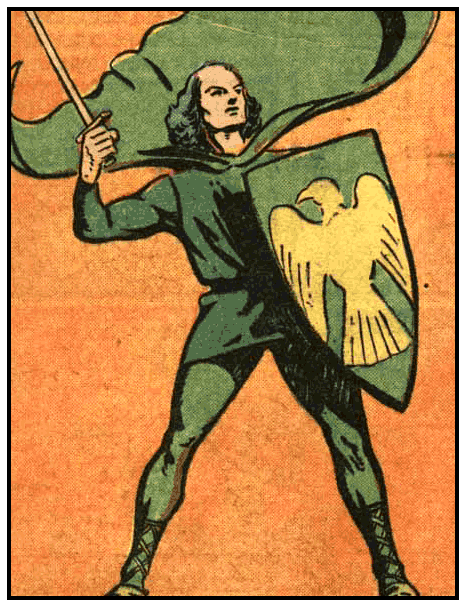 Green Falcon:
1940, Blue Ribbon Comics #4. An outlaw with his own army in the days of the Crusades, a cross between Robin Hood and Ivanhoe. Like Robin Hood,
his opponent is the evil Prince John and girlfriend is a maid Marion.
Green Falcon:
1940, Blue Ribbon Comics #4. An outlaw with his own army in the days of the Crusades, a cross between Robin Hood and Ivanhoe. Like Robin Hood,
his opponent is the evil Prince John and girlfriend is a maid Marion.
Hangman: 1941 Pep Comics 17. Robert Dickering is visiting his brother John when he discovers that John is the avenging Comet. Big Boy Malone’s men come to kidnap John to keep from testifying and grab Bob by mistake. When as the Comet, John is gunned down rescuing his brother, Bob decides to take over the crime-fighting business, first to bring Big Boy Malone to justice. Realizing that all criminals are a cowardly (and superstitious) lot, he comes up with the theme of the Hangman and the image of the gallows to fight crime. Along the way he falls in love with John’s girl as well, Thelma Gordon.
He eventually gets the comical sidekick popular with the heroes in the highly racist African American character Anthracite. Luckily, this didn’t last too long.
Dan Hastings: 1939, Blue Ribbon Comics 1. A sci-fi adventurer ala Buck Rogers, Flash Gordon. Helps Dr. Carter and his daughter Gloria. NOTE: The name Dan Hastings would appear under other comic banners, but always as a sci-fi adventurer though the particulars would change.
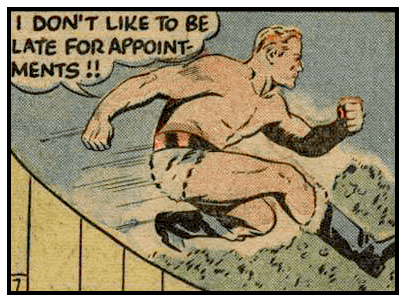 Hercules:
1940, Blue Ribbon Comics #4: For reasons unknown, the demi-god appears in
the streets of modern day New York. He promptly gets work as a vaudevillian
strongman. When his agent is killed by the "lion of the underworld" Leo Nymia
(playing on the Nemean Lion, one of the champion’s 12 labors), he kills Nymia
and wipes out his gang.
Hercules:
1940, Blue Ribbon Comics #4: For reasons unknown, the demi-god appears in
the streets of modern day New York. He promptly gets work as a vaudevillian
strongman. When his agent is killed by the "lion of the underworld" Leo Nymia
(playing on the Nemean Lion, one of the champion’s 12 labors), he kills Nymia
and wipes out his gang.
Inferno, the Flame Breather: 1941, Blue Ribbon Comics. Originally was a crook working with circus rubberman called the Twister. However, decided to serve out his time and go straight after encountering Steel Sterling and even helping him capture another killer, the Rattler. However, while in prison he learns of a plot of escape and the murder of the judge responsible for convicting him and others. In order to save Judge Sands and his daughter, Inferno is forced to escape himself to deal with the convicts. The judge convinces him he can better serve the cause of justice by remaining an escaped convict and taking up the fight as a costumed crime-fighter. He has the super-power of breathing fire from his mouth; he can burn his way through steel doors and walls and can melt bullets before they reach him. As he first appeared as a villain opposing Steel Sterling, my first appearance info could be incorrect since Sterling was usually over in Zip Comics.
Ben "Wings" Johnson: 1939, Top Notch Comics #1. An American pilot who flew for the R.A.F. at the start of the war. When as a kid he was fishing with his friend Jack with Jack's grandfather. Their schooner is sunk and then they are fired upon in the lifeboat by a submarine flying the American flag, killing his pal Jack and Ben swears revenge. Later, he found it was a young German Captain Von Schiller commanding the sub. Naturally, while flying patrol over the English Channel, Ben comes across Von Schiller still up to his old tricks.
Gypsy Johnson: 1940, Blue Ribbon Comics #4. Gypsy is a Texan soldier of fortune and roaming adventurer. He wears a military jacket of the French Foreign Legion when he was on special assignment with them..
Jolly Roger: 1941, Pep Comics ?-27. Roger and his crew known as the Sky Pirates are the best pilots of the RAF. There’s Frank Root, the good looking Brit; C. T. Price, the plump Scotsman and the long faced Aussie Marty.
Joe Jordan: 1939, Blue Ribbon Comics#1. Major Joe Jordan and Denny are with the Diamond Patrol in Africa to investigate smugglers, illegal mining, etc. In their one published adventure "Village of the Missing Men", they are after Barrett who holds women and children of a native village hostage to force the natives to reveal and mine the stones for him and his gang.
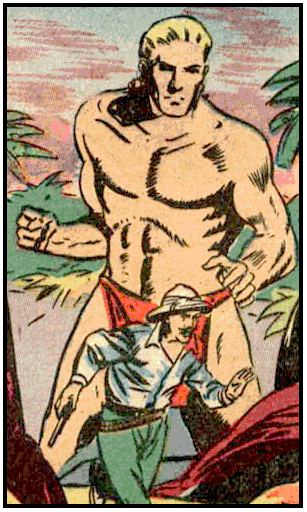 Kalthar:
1940, Zip Comics #1. This bronze jungle lord was raised by the Urganas after
his father died protecting them from Arab slave traders. In addition to being
able to talk to the beasts, the witch doctor Talo gave him red grains that
enables him to grow to 15 feet tall and green grains to restore him to normal height which helps to make him stand out from the many other jungle lords out there. His mate is the brunette Kate Goodwill.
Kalthar:
1940, Zip Comics #1. This bronze jungle lord was raised by the Urganas after
his father died protecting them from Arab slave traders. In addition to being
able to talk to the beasts, the witch doctor Talo gave him red grains that
enables him to grow to 15 feet tall and green grains to restore him to normal height which helps to make him stand out from the many other jungle lords out there. His mate is the brunette Kate Goodwill.
Kardak: 1939, Top Notch Comics #1. Referred to just as "the Mystic" in his early adventures where he shows some mystical ability (to be in a room unseen) but relies mostly on stage magic tricks, escapist skills and his two fists and the assistance of his fiance, also un-named. In issue #4, he gains the name Kardak, a new girlfriend Lorna and actual full blown magic powers. Soon, he also gains a sidekick in Balthar as they go on a multi-part adventure to stop the Master Brahmins who want to rule the world or destroy it.
Stacey Knight: 1939, Top Notch Comics #1? Medical intern has uncanny ability in solving crimes and so is called in to help the police on their difficult cases.
Loop Logan: 1939, Blue Ribbon Comics #1. Loop Logan is an American stunt flyer and top notch air ace assisted by the Far-East Indian Clatra.
Stuart Logan: 1940, Blue Ribbon Comics #3. Stuart Logan is a wealthy Society amateur sleuth. He is called into help solve baffling cases by the DA George Maxwell. Only reported appearance.
The Marvel: 1939, Blue Ribbon Comics #2 & 3. He helps newspaperman Scoop Cody find and capture King Carr but nothing is revealed of the white masked Marvel in this or the next (and last) appearance where he appears at the last moment to rescue Scoop Cody.
Mister Justice: 1940, Blue Ribbon Mystery Comics #9. In 1040 Scots rebels kill Prince James, the heir to the English throne. However, his spirit does not move on but instead kills his assassins and is somehow trapped in the castle. Nine hundred years later, the castle is taken apart and shipped to the US. A U-boat sinks the ship carrying the castle and frees James’ ghost. In the U.S. the ghost becomes Mr. Justice to stop others from being killed the way he was. As a ghost his powers are almost limitless. In addition to being the blue clad hero, he takes on a civilian id also called Mr. Justice.
Mr. Satan: 1940, Zip Comics #1. Clad in a purple costume and yellow cape, Dudley Bradshaw fights crime as Mr. Satan, international detective and soldier of fortune. He runs an ad in the personals advertising his services. He rescues Texa ranch owner Doris O'Day who falls in love with Mr. Satan though Dudley tries to win her heart as himself.
Moore of the Mounted: 1940, Top Notch Comics #4. Sgt. Moore is of the Mounted Police. In his one adventure, he pursues the murderers of an old prospector.
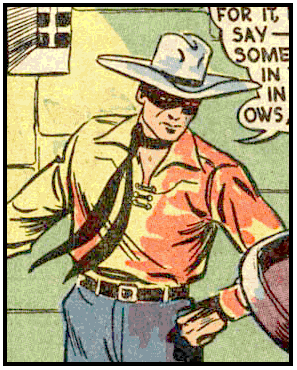 Nevada Jones:
1940, Zip Comics #1. Originally just a cowboy strip, he eventually put on
a mask and became MLJ’s foray into the Lone Ranger business. His white
horse is named Blaze, his sidekick is a Mexican (?) with a tall sombrero called
Little Joe. He's also called the "quick-trigger man" adding a little extra hyperbole to the quick draw cowboy hero idea.
Nevada Jones:
1940, Zip Comics #1. Originally just a cowboy strip, he eventually put on
a mask and became MLJ’s foray into the Lone Ranger business. His white
horse is named Blaze, his sidekick is a Mexican (?) with a tall sombrero called
Little Joe. He's also called the "quick-trigger man" adding a little extra hyperbole to the quick draw cowboy hero idea.
Zoom O'Day: 1942, Zip Comics #30. Zoom is a pilot for the U.S. Marine Corps. He ends up picking up a sidekick in washed up Brooklyn boxer Liverlips. Liverlips flushes out in trying to become a pilot but he proves his worth and value working the bombsight so Zoom keeps him on as his personal bombadier.
Operator #1: 1940, Zip Comics #6? Inez Courtney is a night club blues singer. She’s also secretly part of the Scarlet Avenger’s crime fighting organization. Don't know if she appeared before issue 6, but it is here that the two become a romantic couple. She proves herself to be capable in a fight herself, an invaluable aide to the Scarlet Avenger.
Penny Parker: 1941, Blue Ribbon Comics #13. A young society girl, but one who¹d rather work out in the gym than go to her own coming out party. When she uncovers a thief disguised as a reporter at the party her parents throw for her, she is given the idea of to start her own detective agency with her trainer, the pugilistic Pug.
Press Guardian/the Falcon: 1940, Pep Comics #1-11. In the first issue, Perry Chase, the effete son of the publisher of The Daily Express, has the standard tights and cape costume and is called the Falcon, the press guardian. In the second issue, he’s gone the pulp route, a green suit and fedora with red mask, gloves and tie and his role has become his name. It’s unclear whether he has any real powers or if he’s just strong and a good fighter (with a bulletproof vest since it looks as if he takes a bullet to the chest in one story). His valet Baldwin and love interest Cythia Blake are the only ones to know his secret. NOTE: Starting with Pep 2, the strip was done by Mort (Vigilante, Johnny Quick) Meskin. It’s a joy to read a bunch of these and see his style progress and become more polished.
Scott Rand: 1939, Top Notch Comics #1. Scott Rand is your typical adventurer. He travels through time with Dr. Meade in the "time car" which is more of a rocket ship. In their first adventure they pick up Thor the viking and the lovely Elda in the past. In the second adventure this party of four travel to the future and repel a Martian invasion.
Rang-A-Tang: 1939, Blue Ribbon Comics #1. Rang-A-Tang, the wonder dog, helps Detective ‘Hy’ Speed and the boy Richy Waters (the Amazing Boy) solve all sorts of cases. He was originally a dog at a small carnival but escaped from the cruel trainer and was living in the streets when he saves Detective Speed’s life. After helping him, he gets full status with the police department.
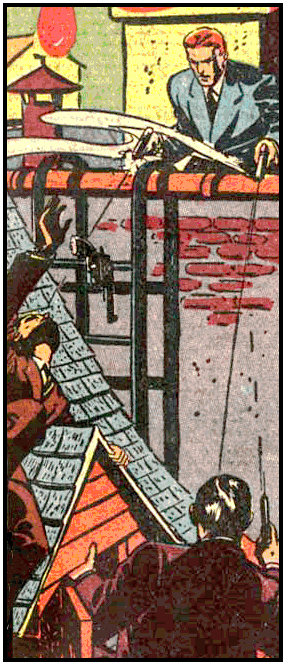 Red Reagan: 1941, Zip Comics #10. Ace detective of the Homicide Squad. The beautiful Bertie Randolph, former laboratory assistant takes it on herself to become Red's assistant after helping to solve a case.
Red Reagan: 1941, Zip Comics #10. Ace detective of the Homicide Squad. The beautiful Bertie Randolph, former laboratory assistant takes it on herself to become Red's assistant after helping to solve a case.
Red Rube: Zip Comics #45. Quoting Jess Nevins fantastic site: Reuben Reuben, an young orphan, finds the castle of his ancestors and discovers that the castle is full of the ghosts of those ancestors. The ghosts are all named "Reuben Reuben," and they grant him special powers, which he uses to fight crime. When Reuben says the magic words "Hey, Rube!" (maybe his ancestors were carny workers?) he turns into Red Rube, who has the powers of each of his ancestors, who were similarly super-powered.
Lee Samson: 1940 Pep Comics #1. The title of the strip was the midshipman, sort of a modern day Hornblower or Frank Merriwell series. He’s a champion athlete in many sports. His love interest is Mae Dennis who he rescued from a plane crash in the first issue. One of the few strips to have crossovers. He appears in an early Shield story, the Wizard appears in one of his and so on.
Scarlet Avenger: 1940, Zip Comics 1. The text of the strip reveals the character to be a ripoff of Street & Smith’s Avenger with a little of the Shadow thrown in. The text box reads: The Scarlet Avenger in real life is Jim Kendall. He has devoted himself to wiping out gangland, ever since the death of his wife and child. An airplane in which they were all flying was hijacked because it was carrying a cargo of gold bullion. It crashed, and all the occupants, except Jim himself, were killed. In the accident, his face muscles were paralyzed and Jim is now the man who never smiles, behind Kendall’s stony face there is a giant scientific brain. He brings science to thee aid of his crusade. He has fashioned for himself a scarlet robe, woven from steel into a super-fine, bullet-proof steel-mesh cloak. His identity is unknown, even to his own aides. The flaming arrow is the emblem of Scarlet Avenger!
And what inventions: the phon viz (a television aparatus to communicate with his aides), an electronic car, a hypnosis machine for extracting information, a flashlight that casts strong enough magnetic rays to repel a speeding auto, a paralysis ray gun. He even supercharges his body with enough electricity that kills his opponents in one adventure. NOTE: Archie published in the 60s a Shadow comic with the hero in a costume not too dissimilar to what we see here.
Shanghai Sheridan: 1940, Top Notch Comics #5. "When Jack Sheridan’s father was killed by the invaders in 1931, young Jack was adopted by his father’s wise and wealthy old friend, Chan Sing-Tan. Jack vowed to avenge his father’s death and swore never to rest until he had driven the invaders from the land of the peaceful Chinese..." and to this end he trains himself to become a marvel in the sciences, the Hindu art of escape, boxing and jiu-jitsu, and ancient Chinese magic and illusion.
Shield: 1940, Pep Comics 1-65 (1948). Joe Higgins’ father makes a great discovery but is killed and branded a traitor before he can reveal more than its acronym: S.H.I.E.L.D. (A whole site could be dedicated to recycled names Marvel Comics made use of in the 60’s). Joe applies himself to all areas of discipline in order to one day clear his father’s name and graduates college with honors. He eventually discovers the secret and it imparts great physical strength. With these powers and his own intelligence he aces the FBI exam and becomes an agent with only J. Edgar Hoover knowing his secret.
He is assisted sometimes by the comical clumsy Ju Ju Watson, a hand to hand combat trainer of the FBI who was more serious and competent when first appeared. Ju Ju’s girlfriend is a ditz named Mamie, while Higgins’ is Betty a sometimes private detective. Later the boy Dusty joins him as a partner as well.
Eventually, Higgins would lose his powers and the process that worked once before failed the second time. Maybe it’s unreliability is why it was never used to create an army of super agents. Or, maybe Joe harbored a deep grudge against the government and FBI for so easily believing his father a traitor.
Silver Fox: 1940, Blue Ribbon Comics #3. Crafty police chief with a white streak down the center of his hair.
Buck Stacey: 1939, Blue Ribbon Comics #1. In the Old West, Buck is a "range detective" and is hired to find some cattle rustlers by ranch owner Sandra Cummings. By the end, he captures both the rustlers and the heart of Sandra.
Steel Sterling: 1940, Zip Comics #1. "When John Sterling’s father was racketeered out of all his great wealth and cruelly murdered by a mob of cut-throat gangsters, young John swore to wreak vengeance on the underworld! He knew that one man alone could not fight the Law’s battle against gangdom unless this one man were forever protected against the underworld’s bullets. He spent his youth in chemical experiments so that when his time to fight was at hand, he might be invulnerable to his enemy’s weapons. His time for revenge is close at hand." He coats himself with a chemical and dives into molten steel and rises out a man as hard and strong as steel. In his first adventure he grants himself speed and flight just by working up an electromagnetic charge by running his fingers through his hair, and follows a plane by magnetizing himself to it. He sets himself up as a private detective and for awhile passes his hero self off as his twin brother as well as making it seem as if John coasts on his brother hero's reputation. Dora Cummings is John's would be girlfriend but she's more interested in Steel. In issue 10, Steel finds the dual role only endangers his friends, so when Twisto, Hefto, and Inferno try to kill John Sterling, he allows everyone to believe they were successful and he becomes Steel Sterling full time (he reveals the ability to control his heart and pulse). He comes clean with Dora about his dual identity and ruse though.
Dick Storm: 1939 Top Notch Comics #2. As the comic sums him up: "Dick Storm, roving adventurer finds himself at Fort Fracasse, A desert outpost of the foreign Legion, famous the world over for his courage, strength, intelligence, and love of adventure.." Storm would travel the world over finding adventure and danger. An early strip by Golden-age great Mort Meskin.
Jack Strand/Jack Strong: 1939, Blue Ribbon Comics #2. Strand/Strong is an adventurous young man and frequently works as a troubleshooter for his wealthy uncle G. Parker Halsey, a financier and trader. Issue #2 has his name as Strand, in #3 it’s Strong. There was no #4 for the young man and his "Secret Assignments." NOTE: Centaur Comics also had a pair of seemingly unrelated Jack Strands indicating this strip more than likely came from the Chesler studio along with Dan Hastings and Lucky Coyne.
Streak Chandler: 1940, Top Notch Comics #4. With Professor Finley, Finley’s daughter Vola and later, the beautiful green woman Laura from Jupiter, Streak has Flash Gordon like adventures on Mars and across the solar system.
Super-boy: Top Notch Comics #8. While always billed as Roy, the Super-boy, his masked identity is that of Super-boy. The Wizard discovered the shoeshine boy Roy Carter fighting a gang of thugs and made him his partner. Roy is able to send mental flashes to the Wizard when in trouble. He teams up with Dusty to form the Boy Buddies.
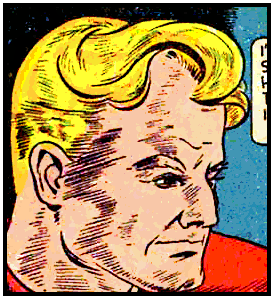 Rex Swift:
1939 Top Notch Comics #1. Secret service agent who has a penchant for disguises,
although his masks are made by the police lab.
Rex Swift:
1939 Top Notch Comics #1. Secret service agent who has a penchant for disguises,
although his masks are made by the police lab.
Three Musketeers: 1942, Jackpot Comics #6. The spirits in the underworld think Mr. Justice is not doing a good enough job fighting the War, so at the bequest of Julius Caesar, Athos, Porthos, Aramis and Napoleon go back to the realm of the living. However, they only make things worse as they underestimate the Nazi cruelty and Hitler's insanity. The Three Musketeers aide in the rescue of prisoners but are shocked when the guards simply machine gun the defenseless men down. Napoleon tries to warn Hitler off his campaign against Russia which only prompts him to make an immediate attack. When it fails, he puts Napoleon on the rack and Napoleon finds he cannot leave the mortal body he assumed. Mr. Justice takes them all back the underworld and addresses the spirits there. Strangely, it's Nero who is the voice of wisdom, saying there has always been doomsayers, saying the world was going to end, that mankind was going to destroy itself, yet somehow mankind manages to work it out and continue on in the end.
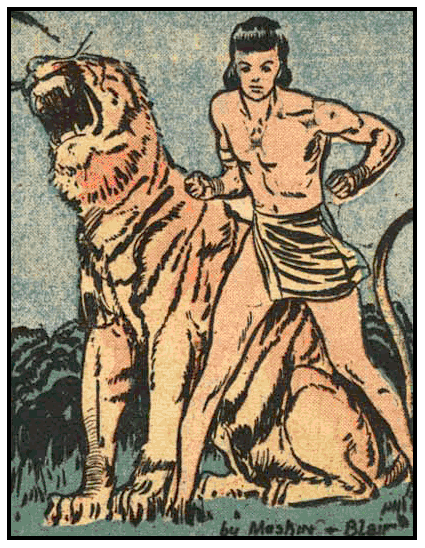 Ty-Gor:
1940, Blue Ribbon Comics #4. Taken as a baby, Tyrone Gorman was offered as a living sacrifice to tigers in the jungles of Malay. Instead, the tigress Malma raises him. He unknowingly is an heir to a fortune back home while he does the Tarzan bit as a young lad accompanied by Malma. He’s found and taken
in by Explorer Davis and his daughter Joan leading to more adventures outside the jungles.
Ty-Gor:
1940, Blue Ribbon Comics #4. Taken as a baby, Tyrone Gorman was offered as a living sacrifice to tigers in the jungles of Malay. Instead, the tigress Malma raises him. He unknowingly is an heir to a fortune back home while he does the Tarzan bit as a young lad accompanied by Malma. He’s found and taken
in by Explorer Davis and his daughter Joan leading to more adventures outside the jungles.
Vagabond: 1942, Zip Comics #30. “V” is the sign of the Vagabond. He's a master of disguise and daring and leads the Valiants, his fellow Czechoslovakian freedom-fighters against the Nazis. He is also a pen pal to Steel Sterling. When Steel hears reports that the Vagabond has turned traitor, he investigates. He finds that the hero has been imprisoned and replaced by an imposter. He races to rescue the Vagabond, but only gets there in time to find him dying from the injuries he's sustained from torture. Even in death, he serves as an inspiration to his Valiants, and they continue to ride forth in his name.
War Eagles: 1940, Zip Comics #1. Tim and Tom Shane are rich American twins also called the Devil's Twins are flying for the British RAF.
Kayo Ward: 1940, Pep Comics #1. Steel worker Eddie Ward becomes lethal heavyweight fighter “Kayo” Ward. He also solves crimes. He undergoes ups and downs before ultimately winning the championship. Among others, he meets Clark Gable, Joe Louis, Edgar Bergen and Charlie McCarthy. Joe Palooka type strip of the strong, noble boxer. His girlfriend is one Connie Hodge.
Web: 1942, Zip Comics #27. As kids, John and Tom Raymond were nothing alike. After Tom's third brush with the law he’s sent to reform school, while John throws himself into studying the criminal mind and becoming an authority and lecturer on criminology. One evening, the dam breaks and Professor Raymond sits at home listening to the latest flood reports and doing research when he gets an unexpected visitor: his brother Tom, recently escaped from jail. Tom had cut the phone wires and was there for money. However, he’s caught in a web of his own devising, for when Professor Raymond can’t be reached by telephone, the police check in on him personally and catch his jailbreaker brother. Since then he was inspired to catch criminals with his fists as the Web and his mind as Professor John Raymond. His girlfriend is his one-time student Rose.
John Raymond is a psychology professor with an emphasis on the study of the criminal mind and criminology. Rose promptly figures out that Raymond is the Web. Her father is a pastor and missionary which figures in one story. In addition to being a college lecturer on criminology, John Raymond has also written a book “Treatise on Criminology”. He frequently serves as a consultant and physician in psychiatry cases and knows about various obscure phobias. NOTE: The publishers cannot seem to decide what the Web's hair color is. In the first issue, he has black hair on the cover, is blond in the story except for a few pages he's a redhead. In his origin story in the following issue, he's blond on the splash page, but black hair throughout the story. He's red-headed again on the cover of his third appearance. He sometimes scares crooks by casting the shadow of a web over them. In the text stories especially, he talks of criminals being caught in webs of their own making and other web metaphors. The comic stories tend to focus on his professor background while the text stories focus on his psychology/medical training. Likewise, while his comic stories quickly began to focus more on War based threats, his text stories were more mystery oriented.
West Pointer: 1939, Top Notch Comics #1. Keith Kornell is described as a physical and mental marvel. "Keith Kornell, 19-year-old Kentucky mountaineer is a collateral descendent of President Andrew Jackson. Son of a World War hero, Keith was orphaned at the age of 5, when both of his parents succomed to the ravages of pneumonia epidemic. Reared by a poor relative, Keith's life has been one of dire poverty..." The paper runs a story on him and he meets an old Army buddy of his dad's now a senator and gets himself admitted to West Point where he further distinguishes himself. Of course, he's soon stopping spies and such. His girlfriend is Gerry Seymour, the Major General's daughter.
Wizard: 1939, Top Notch Comics #1. Blane Whitney, the great-great grandson of General Steven Whitney, the revolutionary war hero and younger brother to Chief of Naval Intelligence Grover Whitney. Indeed, through the years, the Whitney's distinguished themselves in service to America and presumably their father was John Whitney who fell in France in 1918. Blane trained himself from youth to be a veritable Doc Savage so that as an adult he has a photographic memory, a powerful mind, Supersensory Perception " aka the ability to see things happening far away. As time passes he proves to be dashing, super-strong, super smart, able to mentally summon and send visions of his friends. In his early adventures, amongst his many gadgets, he also has a pill that grants him super-strength for a limited time and a contra-gravity flask that allows him to defy gravity (though to get anywhere fast, he still uses a plane). Most of those are slowly forgotten as he is streamlined into a more typical hero. He is aided by Roy, the super-boy whom he can communicate and sense telepathically. He’s the publisher/editor of a newspaper where his girlfriend Jane Barlow works who thinks he’s a bit too lazy and laid back but sometimes thinks he may be the Wizard. Really, when your sidekick goes by the same name as your ward, how much good do you think a domino mask is really going to do?
In his early adventures he wore a tux with cape and domino mask. He was sort of a freelance operative receiving missions from his brother Grover Whitney. He made use of many inventions as well as his own incredible abilities. Later, he traded his suit in for blue tights that was at least bulletproof.
Zambini: 1940, Zip Comics #1. The miracle man, he possesses some real magic ability. He also owns a "boomerang" necklace that makes evil magics return to their source allowing him to follow. He loses his abilities when someone makes and maintains physical contact. He speaks magic spells generally by inserting "ab" into the words.
Zog: 1942, Zip Comics #28: In the days of Ancient Rome and Greece, there lived a sea captain by the name of Rex. On a terrible voyage, he loses his ship, his men and only through the appearance of the image of an ancient magician hero named Zog is he able to find his wife and daughter clinging to a log. Marooned in the Land of Fester which is ruled by an evil king. His soldiers strike and kill Rex's wife and take the daughter to sell her in the slave markets and imprison Rex. Zog comes, changes stones to bread and helps Rex escape, make his way through the city and rescue his daughter. Because of Rex's bravery, Zog returns them to their home. Zog's powers come through an “amulet”, what appears to be a large v-shaped metal band around his neck, not dissimilar to Zambini's. The story of Zog and Rex are related by Zambini to an old sea captain who was thinking of committing his suicide as opposed to being a burden on his wife and daughter. The story inspires him that while he is able, he can devote himself to fighting for freedom and do some kind of service for his country. And, while he can do that, he's not a burden.
